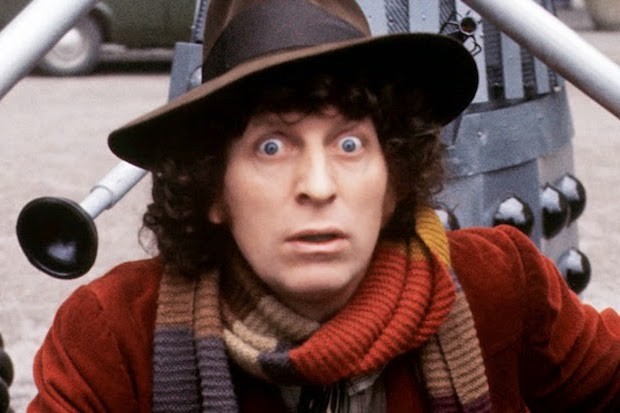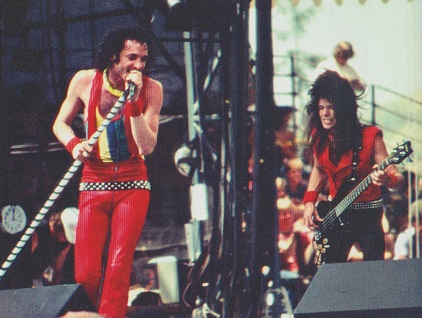RECORD STORE TALES #1093: What Are the Earliest Pieces of Music You Remember Loving?
We are all shaped by our earliest experiences, whether we admit it or not. What were the first songs and pieces of music that you remember loving? Let’s have a look at 10 of mine, from my pre-heavy metal years!
10. The Doctor Who theme.
I grew up with the third and fourth doctors: Jon Pertwee, and Tom Baker. In particular I remember the Baker years as the most important to my childhood. I asked my mom to knit me a long brown scarf like Baker’s Doctor wore. I also remember sitting in front of the TV and recording the intro music to Doctor Who, so I could rewind and play that tape whenever I wanted to. The music was all synth, and entirely spooky, cool and catchy.
9. John Williams’ scores.
Star Wars was first. Empire was second. Raiders was third. Those three soundtracks made up the majority of my musical listening for years. I didn’t own any other records. Just John Williams. When you consider the impact that Holst’s The Planets had on Williams, and heavy metal too, it is no wonder that heavy metal music would later speak so clearly to me.
8. Joey Scarbury – “Theme from The Greatest American Hero (Believe It or Not)”
My earliest musical loves all came from TV or cinema. This was the first non-Williams record I owned, on a 7″ single. Mike Post co-wrote the song, and he would figure into the career of Van Halen much much later. “Believe It Or Not” was a pleasant pop song with an irresistible chorus. The B-side was a ballad called “Little Bit of Us”. I hated it. I remember playing the single at 78 RPM to see if it would make the song any better. It didn’t.
7. Magnum P.I. and The A-Team theme songs.
Here’s Mike Post again, with the theme music to Magnum P.I. starring Tom Selleck. Funky electric guitar hovered behind a bouncing string section playing the theme. It was like my John Williams soundtracks had collided with rock instrumentation. I would sit in bed and hum these themes, singing myself to sleep. And guess who was behind the A-Team’s music? Also Mike Post! Military drums and more symphonic theme greatness. I was well on my way, wasn’t I? These two themes were critically important to the whole action TV show genre.
6. Michael Jackson – “Beat It” and “Thriller”
Like every kid in the mid-80s, I loved Michael Jackson. It would not be an exaggeration to claim that every kid in my grade liked Michael Jackson to a certain degree. He had a number of hits on the radio, including “Say Say Say” with Paul McCartney, which I was frustrated to find was not on my Thriller cassette. Of course, I had no idea who Eddie Van Halen was yet, but he was in my head, playing the “Beat It” guitar solo without my knowledge. Michael’s songs were perfectly written and produced. His videos were groundbreaking, but I hadn’t seem them yet. I wasn’t even sure what he looked like at first. Tabloid photos always showed a gaunt Jackson hiding from the cameras. Once we saw his videos, I was shocked at how effeminate his speaking voice was, for a guy who sang so powerfully. Yet, I only played two or three songs on the tape.
5. Culture Club – “Karma Chameleon”
Hot on the heels of Jackson was Boy George. “Karma Chameleon” was impossible to forget, and I could care less about any of his other hits. I had the Colour By Numbers cassette and never played it except for one song. The album cover shocked me! I thought Culture Club was synonymous with Boy George – a one-man band. I had no idea there were other members, or what they looked like. I liked the tune, but this band was not for me. Eventually I would erase both Jackson and Boy George, and record other things on their tapes.
4. Styx – Kilroy Was Here
“Mr. Roboto” was the song that hooked me, but the album itself was pretty good: “Cold War”, “High Time”, “Don’t Let It End (Reprise)”, “Heavy Metal Poisoning” and “Double Life” were awesome rock songs! As before, I had no interest in the ballads. I played them once or twice, and just skipped them from then on. Styx were the first band with multiple singers that I liked: Dennis DeYoung, Tommy Shaw, and James Young. I wonder what influence this would later have on my love of KISS. Styx were bombastic and huge. The gatefold album came with lyrics, which I studied as if they were containing deep hidden meaning.
3. AC/DC – “Dirty Deeds Done Dirt Cheap”
I recorded this song from my best friend Bob, along with “The Mighty Quinn” by Manfred Mann, and if memory serves, “Ooby Dooby” by Roy Orbison. I might be wrong on that last one, but AC/DC was the one I kept playing over and over, sometimes to irritate people. I remember distinctly telling people I liked the chorus because the singer sounded like “he had a frog in his throat”. My classmate Alan Runstedtler said “I like songs with the guy with the frog in his throat!” and so did I. It was pure comedy and novelty to me, but the guitars lay the groundwork for what would come later.
2. John Fogerty – “The Old Man Down the Road”
MuchMusic had arrived! I had no idea who Fogerty was, or that he was in a legendary rock band called Creedence Clearwater Revival. All I knew was that he had a really, really cool music video on TV, and I couldn’t stop watching it. The upbeat bluesy song with rattling slide guitar seemed cool to me. I decided that I liked John Forgerty based on that one song. I was slowly discovering rock music, and the last song on this list was the last one I loved before going full-metal in 1984.
1. Quiet Riot – “Cum On Feel the Noize”
I didn’t know what they looked like. I didn’t know anything about their prior history, the two Japanese albums, or Randy Rhoads. All I knew was I had finally found “my thing”. My sound. Bombastic, big, loud, catchy, well-written, and perfect.
Without Quiet Riot, I may never have taken my next tenative steps: Helix, Iron Maiden, Judas Priest, and W.A.S.P. All much heavier than Quiet Riot. Without Styx, I might never got gotten into Quiet Riot. Without John Williams, I might never had dug into Styx. Who knows?
I loved Quiet Riot well past their best-before date. I remember other kids at school making fun of me for calling Quiet Riot my favourite band. “They’re out!” laughed Ian Johnson. “Duran Duran are current!”
Fuck Duran Duran.
My journey into metal was natural and organic. I don’t know if those kids from school even listen to music anymore. Their loss.
































